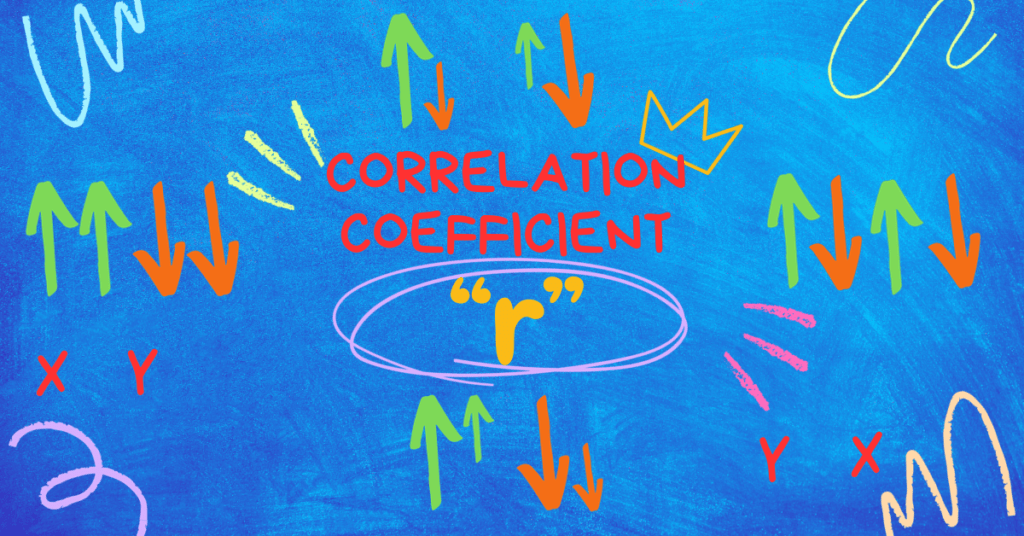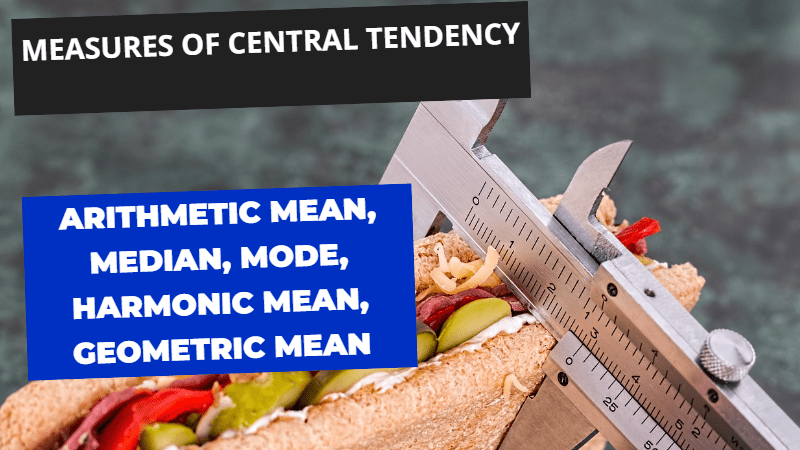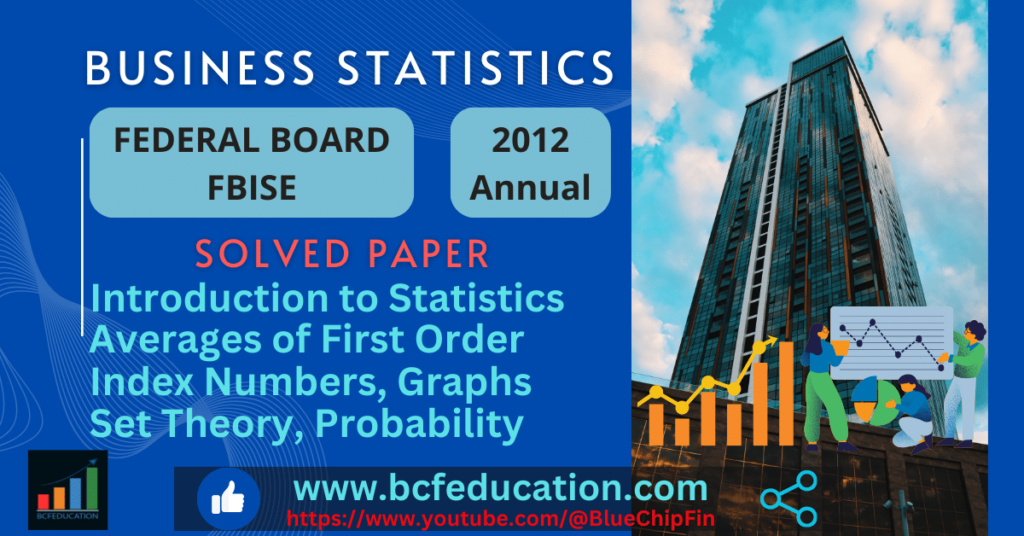In this Post, we are going to discuss the Paper of Business Statistics and Mathematics Solved Paper 2011, Punjab University, BCOM, ADCI in which Measures of Central Tendency, Measures of Dispersion, Correlation & Regression, Index Numbers, Matrix, Arithmetic Progression, Geometric Progression, Simultaneous Linear Equations, Annuity, Quadratic Equation is discussed and solved. Solved Paper 2007 Punjab University , Solved Paper 2008, Solved Paper 2009 and Solved Paper 2010 have already posted.
Table of Contents
Business Statistics and Mathematics Solved Paper 2011, Punjab University, BCOM, ADC I
Solved by Iftikhar Ali, M.Sc Economics, MCOM Finance Lecturer Statistics, Finance and Accounting
Section I Business Statistics
Q.1 Required: Obtain Mean, Median and Coefficient of Variation
| Classes | Frequency | Classes | Frequency |
| 12.5—17.5 | 2 | 37.5—42.5 | 4 |
| 17.5—22.5 | 22 | 42.5—47.5 | 6 |
| 22.5—27.5 | 19 | 47.5—52.5 | 1 |
| 27.5—32.5 | 14 | 52.5—57.5 | 1 |
| 32.5—37.5 | 3 |
Solution
| Classes | Frequency (f) | X | fx | fx² | C.f |
| 12.5—17.5 | 2 | 15 | 30 | 450 | 2 |
| 17.5—22.5 | 22 | 20 | 440 | 8800 | 24 |
| 22.5—27.5 | 19 | 25 | 475 | 11875 | 43 |
| 27.5—32.5 | 14 | 30 | 420 | 12600 | 57 |
| 32.5—37.5 | 3 | 35 | 105 | 3675 | 60 |
| 37.5—42.5 | 4 | 40 | 160 | 6400 | 64 |
| 42.5—47.5 | 6 | 45 | 270 | 12150 | 70 |
| 47.5—52.5 | 1 | 50 | 50 | 2500 | 71 |
| 52.5—57.5 | 1 | 55 | 55 | 3025 | 72 |
| Sum | 72 | 2005 | 61475 | ||
| ∑f= | ∑fx= | ∑fx²= |
\[ \left( \mathbf{a} \right)\mathbf{\ A.M\ }\overline{\mathbf{X}}\mathbf{=}\frac{\mathbf{\sum fx}}{\mathbf{\sum f}}\mathbf{= \ }\frac{\mathbf{2005}}{\mathbf{72}}\mathbf{= 27.84\ }\ \]
Selection of class for median
\[ \frac{\mathbf{n}}{\mathbf{2}}\mathbf{=}\frac{\mathbf{72}}{\mathbf{2}}\mathbf{= 36\ falls\ in\ c.f\ of\ 43\ so\ model\ class\ is\ }\mathbf{22.5—27.5}\ \]
\[ \left( \mathbf{b} \right)\mathbf{Median = L + \ }\frac{\mathbf{h}}{\mathbf{f}}\left( \frac{\mathbf{n}}{\mathbf{2}}\mathbf{- \ C} \right)\mathbf{= 22.5 + \ }\frac{\mathbf{5}}{\mathbf{19}}\left( \mathbf{36 – \ 24} \right)\mathbf{= 25.65}\ \]
\[ \left( \mathbf{c} \right)\mathbf{Coefficient\ of\ Variation\ C.V = \ }\left( \frac{\mathbf{S.D}}{\mathbf{Mean}} \right)\mathbf{100}\ \]
\[ \mathbf{S.D =}\sqrt{\left\lbrack \frac{\mathbf{\sum f}\mathbf{x}^{\mathbf{2}}}{\mathbf{\sum f}}\mathbf{- \ }\left( \frac{\mathbf{\sum fx}}{\mathbf{\sum f}} \right)^{\mathbf{2}} \right\rbrack}\mathbf{=}\sqrt{\left\lbrack \frac{\mathbf{61475}}{\mathbf{72}}\mathbf{- \ }\left( \frac{\mathbf{2005}}{\mathbf{72}} \right)^{\mathbf{2}} \right\rbrack}\ \]
\[ \mathbf{S.D =}\sqrt{\left\lbrack \mathbf{853.819 – \ 775.467} \right\rbrack}\ \]
\[ \textbf{S.D = 8.85} \]
\[ \mathbf{Coefficient\ of\ Variation\ C.V = \ }\left( \frac{\mathbf{8.85}}{\mathbf{27.84}} \right)\mathbf{100 = 31.79\%}\ \]
Q.2
X: 5 6 7 8 9 10 11 12 13 14 15
Y: 9 7 10 3 13 11 14 10 14 12 18
Required: Calculate coefficient of correlation and also the line of regression y on x
Solution:
Solution: Correlation Coefficient
Formula:
\[ \mathbf{r =}\frac{\frac{\mathbf{\sum xy}}{\mathbf{n}}\mathbf{- \ }\left( \frac{\mathbf{\sum x}}{\mathbf{n}} \right)\left( \frac{\mathbf{\sum y}}{\mathbf{n}} \right)}{\mathbf{Sx \times Sy}}\ \]
| S/No | X | Y | XY | X² | Y² |
| 1 | 5 | 9 | 45 | 25 | 81 |
| 2 | 6 | 7 | 42 | 36 | 49 |
| 3 | 7 | 10 | 70 | 49 | 100 |
| 4 | 8 | 3 | 24 | 64 | 9 |
| 5 | 9 | 13 | 117 | 81 | 169 |
| 6 | 10 | 11 | 110 | 100 | 121 |
| 7 | 11 | 14 | 154 | 121 | 196 |
| 8 | 12 | 10 | 120 | 144 | 100 |
| 9 | 13 | 14 | 182 | 169 | 196 |
| 10 | 14 | 12 | 168 | 196 | 144 |
| 11 | 15 | 18 | 270 | 225 | 324 |
| SUM | 110 | 121 | 1302 | 1210 | 1489 |
| ∑X = | ∑Y = | ∑XY = | ∑X² = | ∑Y² = |
\[ \overline{\mathbf{X}}\mathbf{=}\frac{\mathbf{\sum X}}{\mathbf{n}}\mathbf{=}\frac{\mathbf{110}}{\mathbf{11}}\mathbf{= 10\ ,\ }\overline{\mathbf{Y}}\mathbf{=}\frac{\mathbf{\sum Y}}{\mathbf{n}}\mathbf{=}\frac{\mathbf{121}}{\mathbf{11}}\mathbf{= 11\ }\ \]
\[ \mathbf{Sx =}\sqrt{\left\lbrack \frac{\mathbf{\sum}\mathbf{x}^{\mathbf{2}}}{\mathbf{n}}\mathbf{- \ }\left( \frac{\mathbf{\sum x}}{\mathbf{n}} \right)^{\mathbf{2}} \right\rbrack}\ \]
\[ \mathbf{Sx =}\sqrt{\left\lbrack \frac{\mathbf{1210}}{\mathbf{11}}\mathbf{- \ }\left( \mathbf{10} \right)^{\mathbf{2}} \right\rbrack}\ \]
\[ \mathbf{Sx =}\sqrt{\mathbf{110 – 100}}\ \]
\[ \mathbf{Sx =}\sqrt{\mathbf{10}}\ \]
\[ \mathbf{Sx = 3.162}\ \]
\[ \mathbf{Sy =}\sqrt{\left\lbrack \frac{\mathbf{\sum}\mathbf{y}^{\mathbf{2}}}{\mathbf{n}}\mathbf{- \ }\left( \frac{\mathbf{\sum y}}{\mathbf{n}} \right)^{\mathbf{2}} \right\rbrack}\ \]
\[ \mathbf{Sy =}\sqrt{\left\lbrack \frac{\mathbf{1489}}{\mathbf{11}}\mathbf{- \ }\left( \mathbf{11} \right)^{\mathbf{2}} \right\rbrack}\mathbf{\ }\ \]
\[ \mathbf{Sy =}\sqrt{\mathbf{135.36 – 121}}\ \]
\[ \mathbf{Sy =}\sqrt{\mathbf{14.36}}\ \]
\[ \mathbf{Sy = 3.78}\ \]
\[ \mathbf{r =}\frac{\frac{\mathbf{\sum xy}}{\mathbf{n}}\mathbf{- \ }\left( \frac{\mathbf{\sum x}}{\mathbf{n}} \right)\left( \frac{\mathbf{\sum y}}{\mathbf{n}} \right)}{\mathbf{Sx \times Sy}}\ \]
\[ \mathbf{r =}\frac{\frac{\mathbf{1302}}{\mathbf{11}}\mathbf{- \ }\left( \mathbf{10} \right)\left( \mathbf{11} \right)}{\left( \mathbf{3.162} \right)\mathbf{\times (3.78)}}\ \]
\[ \mathbf{r =}\frac{\mathbf{118.36\ –\ 110}}{\mathbf{11.95}}\ \]
\[ \mathbf{r =}\frac{\mathbf{8.36}}{\mathbf{55.95}}\ \]
\[ \mathbf{r = 0.7}) \textbf{(Positive Correlation)} \]
\[ \textbf{Line of Regression Y on X} \]
\[ \widehat{\mathbf{Y}}\mathbf{= a + bx}\ \]
Where:
\[ \mathbf{a =}\overline{\mathbf{Y}}\mathbf{- b}\overline{\mathbf{X}}\]
\[ b_{yx}=r_{xy}\times\frac{Sy}{Sx} \]
\[ b_{yx}=0.7\times\frac{3.78}{3.162}=0.8368 \]
\[ \mathbf{a = 11 – (0.8368)(10)}\ \]
\[ \mathbf{a = 2.632}\ \]
\[ \widehat{\mathbf{Y}}\mathbf{= a + bx}\ \]
\[ \widehat{\mathbf{Y}}\mathbf{= 2.632 + 0.8368x}\ \]
Q.3. A population consists of six numbers 3, 6, 9, 12 and 18. Consider all the possible samples of size 3 which can be drawn without replacement from this population. Calculate:
(i) The Mean of Population
(ii) The Standard Deviation of Population
(iii) The Mean of the Sampling Distribution of Means
(iv) The Standard Error
Solution:
Verification Formulas:
\[ \left( \mathbf{i} \right)\mathbf{\ \mu =}\mathbf{\mu}_{\overline{\mathbf{x}}}\ \]
\[ \left( \mathbf{ii} \right){\mathbf{\ \sigma}\overline{\mathbf{x}}}^{\mathbf{2}}\mathbf{=}\frac{\mathbf{\sigma ²}}{\mathbf{n}}\left\lbrack \frac{\mathbf{N – n}}{\mathbf{N – 1}} \right\rbrack\ \]
\[ \left( \mathbf{iii} \right)\mathbf{\ \sigma}\overline{\mathbf{x}}\mathbf{=}\frac{\mathbf{\sigma ²}}{\sqrt{\mathbf{n}}}\sqrt{\left\lbrack \frac{\mathbf{N – n}}{\mathbf{N – 1}} \right\rbrack}\mathbf{\ }\ \]
Population = 3, 6, 9, 12, 18
Population Size N = 5
Sample size n = 3
\[ \mathbf{Sample\ Space\ \eta}\left( \mathbf{s} \right)\mathbf{=}\begin{pmatrix}\mathbf{N} \\\mathbf{C} \\\mathbf{r} \\\end{pmatrix}\mathbf{=}\begin{pmatrix}\mathbf{5} \\\mathbf{C} \\\mathbf{3} \\\end{pmatrix}\mathbf{= 10}\ \]
| S/No | Samples | Sum of Samples | Mean of Samples |
| 1 | 3, 6, 9 | 18 | 6 |
| 2 | 3, 6, 12 | 21 | 7 |
| 3 | 3, 6, 18 | 27 | 9 |
| 4 | 3, 9, 12 | 24 | 8 |
| 5 | 3, 9, 18 | 30 | 10 |
| 6 | 3, 12, 18 | 33 | 11 |
| 7 | 6, 9, 12 | 27 | 9 |
| 8 | 6, 9, 18 | 33 | 11 |
| 9 | 6, 12, 18 | 36 | 12 |
| 10 | 9, 12, 18 | 39 | 13 |
| Sampling Distribution of Mean of all Samples | |||
| X̅ | f | fX̅ | fX̅² |
| 6 | 1 | 6 | 36 |
| 7 | 1 | 7 | 49 |
| 8 | 1 | 8 | 64 |
| 9 | 2 | 18 | 162 |
| 10 | 1 | 10 | 100 |
| 11 | 2 | 22 | 242 |
| 12 | 1 | 12 | 144 |
| 13 | 1 | 13 | 169 |
| 10 | 96 | 966 | |
| ∑f = | ∑fX̅ = | ∑fX̅²= | |
Mean, Variance & S.D of Sampling Distribution
\[ µ\overline x\;\frac{\sum f\overline x}{\sum f}=\frac{96}{10}=9.6 \]
\[ \sigma^2\overline x\;=\frac{\sum f\overline x^2}{\sum f}-\left(\frac{\sum f\overline x}{\sum f}\right)^2 \]
\[ \mathbf{\sigma}{\overline{\mathbf{x}}}^{\mathbf{2}}\mathbf{=}\frac{\mathbf{966}}{\mathbf{10}}\mathbf{-}\left( \mathbf{9.6} \right)^{\mathbf{2}}\ \]
\[ \mathbf{\sigma}{\overline{\mathbf{x}}}^{\mathbf{2}}\mathbf{= 96.6 – 92.16}\ \]
\[ \mathbf{\sigma}{\overline{\mathbf{x}}}^{\mathbf{2}}\mathbf{= 4.44}\ \]
\[ \sigma\overline x\;=\sqrt{\frac{\sum f\overline x^2}{\sum f}-\left(\frac{\sum f\overline x}{\sum f}\right)^2} \]
\[ \sigma\overline x\;=\sqrt{4.44} \]
\[ \mathbf{\sigma}\overline{\mathbf{x}}\mathbf{= 2.107}\ \]
Mean, Variance & S.D of Population
| X | X² |
| 3 | 9 |
| 6 | 36 |
| 9 | 81 |
| 12 | 144 |
| 18 | 324 |
| 48 | 594 |
| ∑X = | ∑X² = |
\[ \mathbf{Mean\ }\overline{\mathbf{X}}\mathbf{= \ }\frac{\mathbf{\sum X}}{\mathbf{N}}\mathbf{=}\frac{\mathbf{48}}{\mathbf{5}}\mathbf{= 9.6}\ \]
\[ \mathbf{\sigma ² =}\frac{\mathbf{\sum X²}}{\mathbf{N}}\mathbf{-}\left( \frac{\mathbf{\sum X}}{\mathbf{N}} \right)^{\mathbf{2}}\ \]
\[ \mathbf{\sigma ² =}\frac{\mathbf{594}}{\mathbf{5}}\mathbf{-}\left( \mathbf{9.6} \right)^{\mathbf{2}}\ \]
\[ \mathbf{\sigma}^{\mathbf{2}}\mathbf{= 118.8 – 92.16}\ \]
\[ \mathbf{\sigma ² = 26.64}\ \]
\[ \mathbf{\sigma =}\sqrt{\left\lbrack \frac{\mathbf{\sum}\mathbf{X}^{\mathbf{2}}}{\mathbf{N}}\mathbf{-}\left( \frac{\mathbf{\sum X}}{\mathbf{N}} \right)^{\mathbf{2}} \right\rbrack}\ \]
\[ \mathbf{\sigma =}\sqrt{\mathbf{26.64}}\ \]
\[ \mathbf{\sigma = 5.161}\ \]
Verification:
\[ \left( \mathbf{i} \right)\mathbf{\ \mu =}\mathbf{\mu}_{\overline{\mathbf{x}}}\ \]
\[ \mathbf{9.6 = 9.6}\ \]
\[ \left( \mathbf{ii} \right){\mathbf{\ \sigma}\overline{\mathbf{x}}}^{\mathbf{2}}\mathbf{=}\frac{\mathbf{\sigma ²}}{\mathbf{n}}\left\lbrack \frac{\mathbf{N – n}}{\mathbf{N – 1}} \right\rbrack\ \]
\[ \mathbf{4.44}\mathbf{=}\frac{\mathbf{26.64}}{\mathbf{3}}\left\lbrack \frac{\mathbf{5 – 3}}{\mathbf{5 – 1}} \right\rbrack\ \]
\[ \mathbf{4.44}\mathbf{= 4.44}\ \]
\[ \left( \mathbf{iii} \right)\mathbf{\ \sigma}\overline{\mathbf{x}}\mathbf{=}\frac{\mathbf{\sigma}}{\sqrt{\mathbf{n}}}\sqrt{\left\lbrack \frac{\mathbf{N – n}}{\mathbf{N – 1}} \right\rbrack}\mathbf{\ }\ \]
\[ \mathbf{2.107 =}\frac{\mathbf{5.161}}{\sqrt{\mathbf{3}}}\sqrt{\left\lbrack \frac{\mathbf{5 – 3}}{\mathbf{5 – 1}} \right\rbrack}\mathbf{\ }\ \]
\[ \mathbf{2.107 = 2.107}\ \]
Results:
(i) The Mean of Population = 9.6
(ii) The Standard Deviation of Population = 5.161
(iii) The Mean of the Sampling Distribution of Means =9.6
(iv) The Standard Error = 2.107
Q.4. The following data gives the prices and quantities of various commodities for the year 1995 and 2002:
| Commodity | Prices (Rs. Per Quintal) | Quantities (1000 Per Quintal) | ||
| 1995 | 2002 | 1995 | 2002 | |
| A | 60 | 80 | 270 | 290 |
| B | 40 | 45 | 125 | 140 |
| C | 20 | 25 | 130 | 140 |
| D | 55 | 70 | 270 | 350 |
Calculate weighted index number of prices for the year 2002 by taking the year 1995 as base year and using formulae recommended by Laspeyre, Fisher, Paasche’s and Marshall
Solution:
| Commodity | 1995 | 2002 | ||||||
| Price Po | Quantity q0 | Price P1 | Quantity q1 | \[ \mathbf{p}_{\mathbf{o}}\mathbf{q}_{\mathbf{o}}\ \] | \[ \mathbf{p}_{\mathbf{1}}\mathbf{q}_{\mathbf{1}}\ \] | \[ \mathbf{p}_{\mathbf{1}}\mathbf{q}_{\mathbf{o}}\ \] | \[ \mathbf{p}_{\mathbf{o}}\mathbf{q}_{\mathbf{1}}\ \] | |
| A | 60 | 270 | 80 | 290 | 16200 | 23200 | 21600 | 17400 |
| B | 40 | 125 | 45 | 140 | 5000 | 6300 | 5625 | 5600 |
| C | 20 | 130 | 25 | 140 | 2600 | 3500 | 3250 | 2800 |
| D | 55 | 270 | 70 | 350 | 14850 | 24500 | 18900 | 19250 |
| 38650 | 57500 | 49375 | 45050 | |||||
| \[ \mathbf{\sum}\mathbf{p}_{\mathbf{o}}\mathbf{q}_{\mathbf{o}}\ \] | \[ \mathbf{\sum}\mathbf{p}_{\mathbf{1}}\mathbf{q}_{\mathbf{1}}\ \] | \[ \mathbf{\sum}\mathbf{p}_{\mathbf{1}}\mathbf{q}_{\mathbf{o}}\ \] | \[ \mathbf{\sum}\mathbf{p}_{\mathbf{o}}\mathbf{q}_{\mathbf{1}}\ \] | |||||
\[ \left( \mathbf{i} \right)\mathbf{Laspeyr}\mathbf{e}^{\mathbf{‘}}\mathbf{s\ Index}\mathbf{\ 2002}\mathbf{=}\frac{\mathbf{\sum}\mathbf{p}_{\mathbf{1}}\mathbf{q}_{\mathbf{0}}}{\mathbf{\sum}\mathbf{p}_{\mathbf{0}}\mathbf{q}_{\mathbf{0}}}\mathbf{\times \ 100}\ \]
\[ \mathbf{Laspeyr}\mathbf{e}^{\mathbf{‘}}\mathbf{s\ Index}\mathbf{\ 2002}\mathbf{=}\frac{\mathbf{49375}}{\mathbf{38650}}\mathbf{\ \times \ 100 = \ 127.75}\ \]
\[ \left( \mathbf{ii} \right)\mathbf{Paasch}\mathbf{e}^{\mathbf{‘}}\mathbf{s\ Index\ 2002}\mathbf{=}\frac{\mathbf{\sum}\mathbf{p}_{\mathbf{1}}\mathbf{q}_{\mathbf{1}}}{\mathbf{\sum}\mathbf{p}_{\mathbf{0}}\mathbf{q}_{\mathbf{1}}}\mathbf{\times \ 100}\ \]
\[ \mathbf{Paasch}\mathbf{e}^{\mathbf{‘}}\mathbf{s\ Index\ 2002}\mathbf{=}\frac{\mathbf{57500}}{\mathbf{45050}}\mathbf{\times \ 100 = 127.64}\ \]
\[ \left( \mathbf{iii} \right)\mathbf{Fishe}\mathbf{r}^{\mathbf{‘}}\mathbf{s\ Ideal\ Index\ 2002 =}\sqrt{\mathbf{L \times P}}\ \]
\[ \mathbf{Fishe}\mathbf{r}^{\mathbf{‘}}\mathbf{s\ Ideal\ Index\ 2002 =}\sqrt{\mathbf{127.75 \times 127.64}}\ \]
\[ \mathbf{Fishe}\mathbf{r}^{\mathbf{‘}}\mathbf{s\ Ideal\ Index\ 2002 = 127.69}\ \]
\[ \left( \mathbf{iv} \right)\mathbf{\ Marsha}\mathbf{l}^{\mathbf{‘}}\mathbf{s\ Index\ 2002 =}\left( \frac{\mathbf{\sum}\mathbf{p}_{\mathbf{1}}\mathbf{q}_{\mathbf{0}}\mathbf{+ \sum}\mathbf{p}_{\mathbf{1}}\mathbf{q}_{\mathbf{1}}}{\mathbf{\sum}\mathbf{p}_{\mathbf{0}}\mathbf{q}_{\mathbf{0}}\mathbf{+ \sum}\mathbf{p}_{\mathbf{0}}\mathbf{q}_{\mathbf{1}}} \right)\mathbf{\times 100}\ \]
\[ \]
\[ \mathbf{Marsha}\mathbf{l}^{\mathbf{‘}}\mathbf{s\ Index\ 2002 =}\left( \frac{\mathbf{49375 + 57500}}{\mathbf{38650 + 45050}} \right)\mathbf{\times 100}\ \]
\[ \mathbf{Marsha}\mathbf{l}^{\mathbf{‘}}\mathbf{s\ Index\ 2002 =}\left( \frac{\mathbf{106875}}{\mathbf{83700}} \right)\mathbf{\times 100}\ \]
\[ \mathbf{Marsha}\mathbf{l}^{\mathbf{‘}}\mathbf{s\ Index\ 2002 = 127.69}\ \]
Section I Business Mathematics
Q.5 If:
\[\textbf{ A =} \begin{bmatrix}\mathbf{1} & \mathbf{3} & \mathbf{2} \\\mathbf{3} & \mathbf{2} & \mathbf{0} \\\mathbf{4} & \mathbf{5} & \mathbf{6} \\\end{bmatrix}\mathbf{\ \&\ B =}\begin{bmatrix}\mathbf{- 2} & \mathbf{5} & \mathbf{4} \\\mathbf{0} & \mathbf{3} & \mathbf{- 5} \\\mathbf{- 1} & \mathbf{4} & \mathbf{2} \\\end{bmatrix} \]
Calculate (i)A – 3B (ii) AB
Solution
\[ \mathbf{3}\mathbf{B =}\begin{bmatrix}\mathbf{- 6} & \mathbf{15} & \mathbf{12} \\\mathbf{0} & \mathbf{9} & \mathbf{- 15} \\\mathbf{- 3} & \mathbf{12} & \mathbf{6} \\\end{bmatrix}\mathbf{,\ }\mathbf{A – \ 3}\mathbf{B =}\begin{bmatrix}\mathbf{1 + 6} & \mathbf{3 – 15} & \mathbf{2 – 12} \\\mathbf{3 – 0} & \mathbf{2 – 9} & \mathbf{0 + 15} \\\mathbf{4 + 3} & \mathbf{5 – 12} & \mathbf{6 – 6} \\\end{bmatrix}\ \]
\[ \mathbf{A – \ 3}\mathbf{B =}\begin{bmatrix}\mathbf{7} & \mathbf{- 12} & \mathbf{- 10} \\\mathbf{3} & \mathbf{- 7} & \mathbf{15} \\\mathbf{7} & \mathbf{- 7} & \mathbf{0} \\\end{bmatrix}\ \]
\[ \textbf{(ii)} \mathbf{AB = \ }\begin{bmatrix}\mathbf{1( – 2) + 3 \times 0 + 2( – 1)} & \mathbf{1 \times 5 + 3 \times 3 + 2 \times 4} & \mathbf{1 \times 4 + 3( – 5) + 2 \times 2} \\\mathbf{3( – 2) + 2 \times 0 + 0( – 1)} & \mathbf{3 \times 5 + 2 \times 3 + 0 \times 4} & \mathbf{3 \times 4 + 2( – 5) + 0 \times 2} \\\mathbf{4( – 2) + 5 \times 0 + 6( – 1)} & \mathbf{4 \times 5 + 5 \times 3 + 6 \times 4} & \mathbf{4 \times 4 + 5( – 5) + 6 \times 2} \\\end{bmatrix}\ \]
\[ \mathbf{AB = \ }\begin{bmatrix}\mathbf{- 2 + 0 – 2} & \mathbf{5 + 9 + 8} & \mathbf{4 – 15 + 4} \\\mathbf{- 6 + 0 – 0} & \mathbf{15 + 6 + 0} & \mathbf{12 – 10 + 0} \\\mathbf{- 8 + 0 – 6} & \mathbf{20 + 15 + 24} & \mathbf{16 – 25 + 12} \\\end{bmatrix}\ \]
\[ \mathbf{AB = \ }\begin{bmatrix}\mathbf{- 4} & \mathbf{22} & \mathbf{- 7} \\\mathbf{- 6} & \mathbf{21} & \mathbf{2} \\\mathbf{- 14} & \mathbf{59} & \mathbf{3} \\\end{bmatrix}\ \]
Q.6(a) Solve the following
\[ \mathbf{x}\mathbf{²}\mathbf{+ 5}\mathbf{x = 50}\ \]
Solution
\[ \mathbf{x}\mathbf{²}\mathbf{+ 5}\mathbf{x – \ 50}\ \]
\[ \mathbf{x =}\frac{\mathbf{- b \pm}\sqrt{\mathbf{b}^{\mathbf{2}}\mathbf{- 4}\mathbf{ac}}}{\mathbf{2}\mathbf{a}}\mathbf{\ where\ a = 1,\ b = \ 5\ \&\ c = \ – 50}\ \]
\[ \mathbf{x =}\frac{\mathbf{( – 5) \pm}\sqrt{\left( \mathbf{5} \right)^{\mathbf{2}}\mathbf{- 4(1)( – 50)}}}{\mathbf{2(1)}}\ \]
\[ \mathbf{x =}\frac{\mathbf{- 5 \pm}\sqrt{\mathbf{25}\mathbf{+ 200}}}{\mathbf{2}}\ \]
\[ \mathbf{x =}\frac{\mathbf{- 5 \pm}\sqrt{\mathbf{225}}}{\mathbf{2}}\ \]
\[ \mathbf{x =}\frac{\mathbf{- 5 \pm 15}}{\mathbf{2}}\ \]
\[ \mathbf{x =}\frac{\mathbf{- 5 + 15}}{\mathbf{2}}\mathbf{=}\frac{\mathbf{10}}{\mathbf{2}}\mathbf{= 5}\ \]
\[ \mathbf{x =}\frac{\mathbf{- 5 – 15}}{\mathbf{12}}\mathbf{=}\frac{\mathbf{- 20}}{\mathbf{2}}\mathbf{= – 10}\ \]
(b) The sum of two consecutive even integers is 66. Find the numbers.
Solution
x + x+2 = 66
2x + 2 = 66
2x = 66 – 2
2x = 64
x = 64/2 = 32
First Integer = x = 32
Second Integer = x + 2 = 32+ 2 = 34
Sum of two integers is 66
32 + 34 = 66
Q.7 (a) The 54th and 4th terms of an A.P are -61 and 64 respectively. Show that the common difference is -2.5 and 23rd term is 16.5.
Solution:
Α54 = -61, α4 = 64
αn = α1 + (n – 1)d
α54 = α1 + (54 – 1)d
-61 = α1 + 53d………….(i)
αn = α1 + (n – 1)d
α4 = α1 + (4 – 1)d
64 = α1 + 3d………….(ii)
Subtract equation i & ii
-61 = α1 + 53d ………….(i)
±64 = ±α1 ± 3d ………….(ii)
-125 = 50d
50d = -125
\[ \mathbf{d}\mathbf{= \ }\frac{\mathbf{- 125}}{\mathbf{50}}\mathbf{=}\mathbf{-}\mathbf{\ 2.5}\ \]
Now we will find the value of α1 by putting the value of d in any equation
64 = α1 + 3d ………….(ii)
64 = α1 + 3(-2.5)
64 = α1 – 7.5
α1 = 64 + 7.5
α1 = 71.5
Hence
α 23 = α1 + (23 – 1)d
α 23 = 71.5 + (22)(-2.5)
α 23 = 71.5 – 55 α 23= 16.5
(b) Show that the sum of the series 0.53 + 0.0053 +………0.000053 + to infinity is 53/99.Solution
\[ \mathbf{S\infty =}\frac{\mathbf{a}\mathbf{1}}{\mathbf{1 – r}}\mathbf{\ where\ a}\mathbf{1 = 0.53\ \&\ r = 0.0,\ so:}\ \]
\[ \mathbf{S\infty =}\frac{\mathbf{a}\mathbf{1}}{\mathbf{1 – r}}\mathbf{=}\frac{\mathbf{0.53}}{\mathbf{1 – 0.01}}\mathbf{=}\frac{\mathbf{0.53}}{\mathbf{0.99}}\mathbf{=}\frac{\mathbf{0.53}}{\mathbf{0.99}}\mathbf{=}\frac{\mathbf{53}}{\mathbf{99}}\mathbf{\ }\ \]
Q.8 (a) A property changed hands 3 times and at each time the loss to the seller was 10%. If in the last transaction the loss was Rs. 202.50. Find out the original value of the property.
Solution:
Let the original price of the property = 100
10% loss on first selling = 10
Remaining Value = (100 – 10 = 90)
10% loss on second selling = 9
Remaining Value = (90 – 9 = 81)
10% loss on third selling = 8.10
Remaining Value = (81 – 8.10 = 72.9)
If the loss is 202.50, the original price will be:
\[ \mathbf{Original\ Price = \ }\frac{\mathbf{202.50\ \times \ 100}}{\mathbf{8.10}}\mathbf{= Rs = 2500}\ \]
(b) The difference between the simple and compound interest on a certain sum is Rs. 31 for three years at 10% p.a. Find out the sum.
Solution
Assumed Principal Value = 100, n or N = 3, I or i = 5% = 0.05, Difference = 61
S.I = PIN
S.I = 100×0.10×3 = 30
\[ {\mathbf{C}\mathbf{.}\mathbf{I}\mathbf{=}\mathbf{P}\mathbf{(}\mathbf{1}\mathbf{+}\mathbf{i}\mathbf{)}}^{\mathbf{n}}\mathbf{- p}\ \]
\[ {\mathbf{C}\mathbf{.}\mathbf{I}\mathbf{=}\mathbf{100}\mathbf{(}\mathbf{1}\mathbf{+}\mathbf{0}\mathbf{.}\mathbf{10}\mathbf{)}}^{\mathbf{3}}\mathbf{- 100}\ \]
\[ \mathbf{C}\mathbf{.}\mathbf{I}\mathbf{=}\mathbf{100}\mathbf{(}\mathbf{1}\mathbf{.}\mathbf{331}\mathbf{)}\mathbf{-}\mathbf{100}\ \]
\[ \mathbf{C}\mathbf{.}\mathbf{I}\mathbf{=}\mathbf{133.1 – 100}\ \]
\[ \mathbf{C}\mathbf{.}\mathbf{I}\mathbf{=}\mathbf{33.1}\ \]
Difference between Simple & Compound Interest = 33.1 – 30 = 3.1
\[ \mathbf{Principal}\mathbf{= \ }\frac{\mathbf{100}\mathbf{\ }\mathbf{x}\mathbf{\ }\mathbf{31}}{\mathbf{3.1}}\mathbf{=}\mathbf{Rs}\mathbf{.}\mathbf{1000}\ \]
Sum in Simple Interest = Principal Amount + S.I = 1000 + 30 = 1030
Sum in Compound Interest = Principal Amount + C.I = 1000 + 33.1 = 1033.1
You may also like to visit following links:
Business Statistics & Mathematics, Solved Paper 2010, Punjab University, BCOM, ADCI
Business Statistics & Mathematics, Solved Paper 2009, Punjab University, BCOM, ADCI
Business Mathematics and Statistics, Solved Paper 2008, Punjab University, BCOM,ADCI
Business Mathematics and Statistics, Solved Paper 2007, Punjab University, BCOM,ADCI
Introduction to Statistics Basic Important Concepts
Measures of Central Tendency, Arithmetic Mean, Median, Mode, Harmonic, Geometric Mean
Correlation Coefficient, Properties, Types, Important Formulas for Correlation Coefficient





